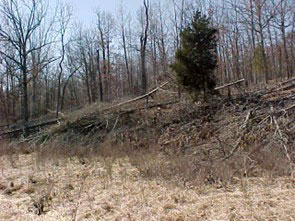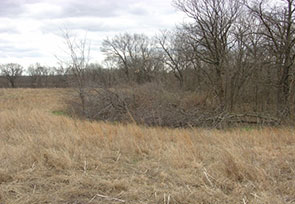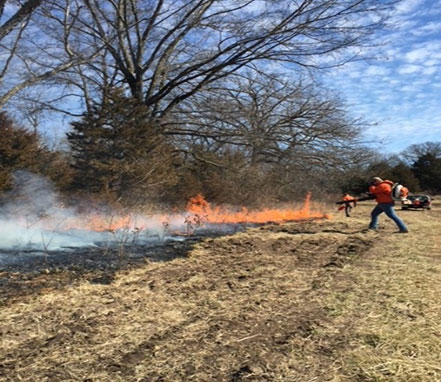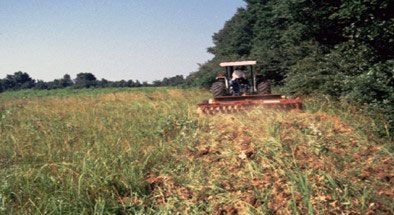Bobwhite quail have more complex habitat requirements than many wildlife species, so it is important for landowners to begin to broaden their perspective on creating "habitat" and focus on implementing management practices that provide more "usable space" for quail. To accomplish this objective, you must create the appropriate mix of early successional plant communities (habitat components) that quail need to meet their seasonal food and cover needs. Once you have identified the habitat components that are missing or limiting on your property, you can then apply the appropriate management techniques, which improve the condition of the habitat and provide more usable space for quail on your farm.

Improving farmland for bobwhites
Quail populations on farmland are affected by the type of crop produced, the size of the field and the agronomic practices that are conducted throughout the year. Also, the condition of fencerow habitats, ditchbanks and other "idle areas" often determines whether quail thrive on your farm. It is important to keep the acreage and shape of individual fields as small and irregular as possible so that edge is maximized. Preferable crops include no-till corn, soybeans, grain sorghum (milo), sunflowers and wheat. Leaving the outer rows unharvested can also provide winter food sources. An optimal agriculture landscape for bobwhites typically contains 15 to 20 percent woody cover, 20 to 30 percent grassy areas, and 40 to 60 percent row crop interspersed with shrubby cover (serving as a covey headquarters area) available every 25 to 200 yards.
Developing field borders
Field borders and vegetative buffers provide important habitats in agricultural areas. These areas can be established and improved by leaving a border of native grasses and legumes around the field edge, the wider the better. Avoid treating field borders with chemicals, and reduce in-field use of pesticides as much as possible. Most of the negative pesticide effects on quail occur indirectly from the reduction of insect populations. Leave fencerows, field borders and corners, ditchbanks, and lanes between fields, and manage wildlife-friendly vegetation (combinations of grasses/forbs and weeds) as a two- to three-year rough area, with small blocks of plums, shrub lespedeza or blackberries. For more specific information on establishing and managing these areas for bobwhite quail and other wildlife, refer to MU Extension publication G9421, Field Borders for Agronomic, Economic and Wildlife Benefits.
Developing a covey headquarters area

Perhaps the most common limiting factor inhibiting quail populations on many Missouri farms is lack of shrubby escape cover. These areas provide locations that the birds tend to use each day for loafing and dusting as well as for protection from predators. For example, within a home range of 15 acres (or an area that a covey will normally use to meet its year-round needs), all the seasonal food and cover requirements need to be met. The area can be made more suitable for quail if scattered patches of dense, shrubby thickets are provided. This cover type is an absolute requirement for bobwhites and is used every day. With the other food and cover needs met nearby, little covey movement is necessary, energy is conserved and predation is reduced. Covey headquarters are characterized by open understory with low to mid-height vegetative cover overhead.
- A covey headquarters should be located within every 5-40 acres and adjacent to wildlife friendly grasses/legumes or within field border habitat surrounding row crop fields.
-
Maintain these areas by removing trees that overtop the shrubby area.
-
Edge feathering can be used in areas of older trees to restore and enhance shrubby habitats.
-
Headquarters shrub plantings should be at least 15 feet wide and 1,200 square feet.
-
Plant shrubs at a 5 X 5 foot spacing.
-
Plant shrub such as dogwoods, American plum, blackberry, aromatic sumac, false indigo. A mix of plants provides vegetative diversity.
-
The entire planting area needs to be free of existing sod forming grasses and vegetation. Remove unwanted cover either by disking or herbicide treatment during the fall prior to shrub planting.
-
Prior to establishing shrubs in the spring, broadcast ladino clover at 2 ¼ lbs./acre or annual lespedeza at 5.6 lbs./acre to suppress annual weeds in the planting area. The shrub area may also be sprayed with an approved herbicide for at least two growing seasons after planting.
Without dense, shrubby cover, you should not expect to restore quail populations on your property.
Promoting woody edge habitats for bobwhites


One of the best locations to begin to develop dense, shrubby cover is along an existing field edge. However, many field edges are characterized by abrupt changes from grass or crop fields to mature trees. Higher quality edge habitat consists of a more gradual transition zone of more diverse plant communities, including grasses, legumes and shrubs. Landowners can quickly create this cover type by hinge-cutting small patches of trees along the field edge. These edges can be created and managed by either planting field borders and edges with a mixture of shrubs, grasses and legumes or cutting larger trees along the field border to promote the growth of shrubby cover. Edge feathering can be used to create woody escape cover along forest edges. This practice will create a transition zone of shrubs, vines, and herbaceous vegetation between cropland or grassland and the wooded area. To be effective, edge feathering should be completed next to early successional vegetation such as managed wildlife friendly grasses/legumes, field borders and food sources such as crop fields or food plots.
Improving pastures and hayfields
Pastures and hayfields provide valuable nesting habitat, and these areas can be improved by planting mixtures of native warm-season grasses (such as, big bluestem, Indian grass and little bluestem) and legumes. These grasses grow in clumps, which afford quail easy access to the food and cover benefits they provide. Livestock producers also benefit by using warm-season grasses in their operation. Establishing an undisturbed 15- to 25-foot field border composed of warm-season grasses and blocks of shrubs (such as plum thickets and blackberry) around a grazed pasture can also be beneficial.
However, even warm-season grasses need to be managed for optimal quail benefits. Overgrazing reduces the available cover and selectively eliminates important legume food plants. Graze at a stocking rate that allows an average of 10 to 12 inches of grass stubble at the end of the growing season. Cattle can be used to create a diversity of vegetative structure that provides roosting, nesting and foraging areas that quail will use. If grazing is not being conducted, it is important to manage these areas using rotational strip disking and prescribed fire on a three- to four-year rotation to encourage legumes, annual weeds and insects. These pastures can be cut for hay between July 15 and Aug. 15 after the prime nesting season for quail.
Many of our cool-season grasses such as orchard grass, timothy and tall fescue have serious limitations for bobwhites when used for hay. Most of these grasses produce their highest quality hay in late May or early June. This coincides with the time when quail and other grassland birds are nesting. Leave an uncut border (at least 50 feet wide) around the field until July 15.
Controlling tall fescue
Tall fescue is an aggressive, nonnative cool-season grass that tends to crowd out important quail food and cover plants. This turf grass also can spread into unintended locations and reduces the availability of more "quail friendly" grasses and legumes from becoming established. Although tall fescue is an important pasture grass in Missouri, it is often heavily grazed, and this also prevents other important food plants from growing. However, there are opportunities to improve tall fescue pastures for quail. The following management activities can help eliminate tall fescue within the field and around the field edge:
- Mow, graze or preferably burn tall fescue in late winter for a spring herbicide treatment or in late summer for a fall herbicide treatment.
- Allow fescue to green up to a height of at least six inches.
- Spray the area with one or two quarts per acre of glyphosate (Roundup) or sulfosate. Two separate treatments are needed to kill fescue.
- After fescue has been killed, establish wildlife-friendly vegetation.
Practices to reduce the dominance of tall fescue include grazing heavily in the winter and overseeding with lespedeza or red clover, disking strips or applying herbicides to small strips throughout the pasture to encourage native annual weeds to grow, and refraining from excessive mowing.
Using prescribed fire

Several tools need to be included in the quail manager's arsenal. One of the most important is the judicious use of prescribed fire, which, in many circumstances, can be one of the best and most cost-effective tools for creating and managing favorable food and cover conditions for bobwhites. Prescribed fire can be recommended as an effective management tool in pine or mixed pine/hardwood forests, old fields, pastures, fallow cropland, CRP fields, and along field borders. Fire improves habitat for quail by setting back the successional stage of an area, controlling undesirable vegetation and reducing wildfire hazards. Fire is best employed on a one to three-year cycle outside of the nesting season, depending on the level of succession that is being managed. Late summer burns may increase forb and legume production. Burning during the spring and fall of the same year is an effective way to reduce stands of cool-season grass, including tall fescue. Fire reduces dead plant material, stimulates desirable legume growth and seed production, exposes mineral soil, and provides open, early successional vegetation stages. Professional guidance and a written burn plan are always recommended when considering the use of prescribed fire for improving habitat for quail.
Strip disking

Soil disturbance is also critical. Light disking can be used to change the composition of the plant community and set back plant succession. Removing dense grasses provides room for better seed producers. Light disking in strips is a technique that involves disking sections through a fallow field, pasture or open woodland during the fall or spring. Make these strips 30 to 50 feet wide, and separate them by undisked strips 60 to 100 feet wide. Make the strips as long as possible, and follow the contour of the land. These strips can be thought of as a rest-rotation system. After a year, disk another swath next to the previously disked strip. This develops a mosaic of vegetation that is one to three years old. Do not allow any vegetation to get older than three years. In addition to the same benefits as burning, disking can dramatically increase insect populations. It provides a technique to increase natural seed production at a fraction of the cost of cultivated plantings.
Mowing
Periodic mowing keeps brush at a preferred height; in wooded habitat, rotary cutting thick hardwood sprouts is beneficial. However, mowing is often a misapplied management tool. Annual mowing of grassy fields and pastures can be detrimental because it tends to encourage dense stands of perennial grasses and causes a buildup of dense litter or thatch that inhibits movement of bobwhites. It is important also to avoid mowing during the nesting season or to delay mowing until after July 15.
Improving woodlands for bobwhites
If you are a forest landowner interested in managing for quail, you will need to keep the forest stand canopy as open as economically feasible. When tree canopies close, sunlight is eliminated from the forest floor and annual seed-producing plants that quail need do not germinate.
Forest stand improvement practices
Whether managing for pine or hardwood, it is important to conduct forest stand improvement practices (such as a crop tree release) and to thin certain trees in the stand as early as possible, before trees reach market size. The timing for implementing a timber stand improvement practice depends on the tree species as well as on the quality of the site. Generally for quail, tree canopies (including the understory and midstory) should not cover more than 50 percent of the ground area. This allows for sunlight to penetrate the canopy, stimulating the growth of annual weeds and legumes. Refer to MU Extension publication G9415, Integrating Woodland and Wildlife Management Practices on Your Property for additional information.
On the appropriate site, managing a forest stand for savannah-like conditions can potentially favor bobwhites. Basal area, or the total cross-sectional areas of wood in the stand, is expressed as square feet per acre. For bobwhite quail, thin timber to a basal area of 25 square feet, which is less than a typical forestry thin. Be sure to work with a forestry professional and seek additional advice prior to making management decisions. Clumps of mast-producing trees (such as white and red oaks) should be left during this thinning process. This crop tree release will favor the production of acorns and other mast.
Establishing openings for habitat improvement
Establishing small openings in the forest and making use of clearcutting techniques can provide excellent quail habitat for the first few years following harvest. Thereafter, unless some soil disturbance or vegetation control is employed, quail habitat is lost. Irregularly shaped cuttings also create additional edge habitats, which are beneficial for quail. The creation of small openings on woodland sites smaller than 40 acres in size will generally not provide much benefit to quail. However, on larger forested tracts, establishing a number of well-scattered, temporary and permanent openings one to three acres in size can provide nesting and brood habitat for quail. Also, leaving as little as 10 percent of the landscape in small, one- to three-acre rotationally cropped agricultural fields, in conjunction with careful thinning and burning, can potentially increase bobwhite quail numbers.
Establishing food plots
The lack of available foods is not usually the most critical limiting factor for bobwhites, and establishing food plots may not be essential. However, food plots can provide important brood-rearing cover for bobwhites as well as a source of emergency foods during periods of extended snow cover. In forested areas with limited amounts of agricultural food crops available, a rotational food planting could be used to provide late winter food sources. For instance, plant a quarter-acre food plot every 15 to 20 acres to a row crop (such as corn, grain sorghum or soybeans) or lespedeza. Move the location of the plot each year to create a mosaic of small plots and annual weed patches. Refer to MU Extension guide G9493, Enhancing White-Tailed Deer Habitats on Your Property: Food Plots, which provides more detailed information on establishing food plots for use by a variety of wildlife species, including bobwhite quail.
Assistance and incentives
Landowners and managers can receive information and assistance for managing bobwhite quail on their property from several sources. Depending on your goals and objectives, this level of assistance can vary from surveys of habitat characteristics to preparation of wildlife management plans for your property.
The Missouri Department of Conservation (MDC) provides technical advice on quail habitat management to landowners across the state. Private Lands Conservationists and Wildlife Management Biologists can provide assistance in habitat evaluations and in making specific management recommendations. Information on bobwhite quail ecology and management is available at no cost. Contact your regional MDC office or visit their website
Both the USDA Farm Services Agency (FSA) and the Natural Resources Conservation Service (NRCS) administer federal farm programs that offer cost-share assistance for implementing practices that potentially benefit bobwhite quail. Landowners can use programs such as the Wildlife Habitat Incentives Program (WHIP), Environmental Quality Incentives Program (EQIP) and Conservation Reserve Program (CRP) to enhance bobwhite quail habitat.
Selected resources for bobwhite quail management
For more information on managing your farm for bobwhite quail, contact a natural resource or wildlife professional with the Missouri Department of Conservation (MDC), USDA Natural Resources Conservation Service (NRCS), Missouri Pheasants and Quail Forever, or MU Extension.